|
Displaying items by tag: John Singer Sargent
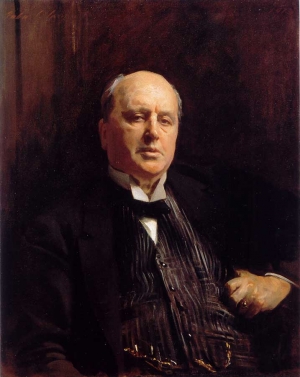
Opening on October 2, 2013 at Tate Britain in London, Art Under Attack: Histories of British Iconoclasm will be the first exhibition to explore the history of physical attacks on art in Britain from the 16th century to the present day. The show will present famously marred works while exploring the religious, political and aesthetic motives that have provoked these violent acts.
The exhibition will include Statue of the Dead Christ (1500-20), which is being loaned to the Tate by London’s Worship Company of Mercers where the work was discovered beneath the chapel floor in 1954. The work was attacked by Protestants during the Reformation and is missing a crown of thorns, arms and lower legs. It is the first time that the Mercer has loaned the work since it was discovered nearly 60 years ago. John Singer Sargent’s (1856-1925) portrait of Henry James, which was attacked by a suffragette at the Royal Academy in 1914 with a knife, will also be on view. A less violently disgraced work is a portrait of Oliver Cromwell that was hung upside down by a devote monarchist. The work is on loan from the Inverness Museum in Scotland.
Art Under Attack: Histories of British Iconoclasm will be on view at Tate Britain through January 5, 2014.

From Colony to Nation: 200 Years of American Painting is an exhaustive exhibition now on view at the New-York Historical Society in Manhattan. The show presents over 80 works dating from 1729 to 1918 from the Historical Society’s own comprehensive collection of American paintings. From early Colonial portraits to urban Impressionism, the exhibition tells the tale of America’s past through art.
Many of the works on view have not been exhibited in decades and have recently undergone conservation efforts. Highlights include John Singer Sargent’s (1856-1925) portrait Mrs. Jacob Wendell (1888), which is the first work by Sargent to join the New-York Historical Society’s collection; Charles Wilson Pearle’s (1741-1827) The Peale Family (1773-1809), which brings together several generations in the artist’s studio; and Childe Hassam’s (1859-1935) Flags on 57th Street, Winter (1918), which offers a glimpse of New York City during its early years as a budding metropolis. From Colony to Nation is arranged thematically. Topics explored include The Early Republic: Patriots, Citizens & Democratic Vistas; A Second War of American Independence: The War of 1812; The Native Scenery & American Narratives; and The Gilded Age: Identity, Nostalgia & the Modern City.
From Colony to Nation: 200 Years of American Painting will be on view at the New-York Historical Society through September 8, 2013.
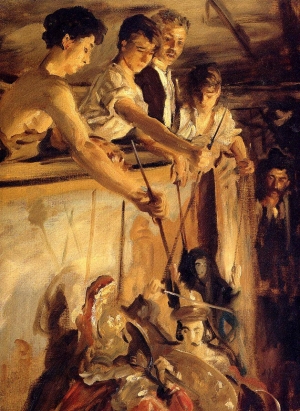
Sotheby’s American Art auction, which took place today, May 22, 2013 in New York, garnered upward of $28 million, surpassing the sale’s high estimate of $24.4 million. Out of the 62 lots offered, 83.9% sold and 93.8% sold by value. This was the third consecutive American art sale at Sotheby’s to exceed its high estimate.
The auction’s top lot was the highly anticipated John Singer Sargent (1856-1925) painting Marionettes (1907), which achieved $5.2 million (estimate: $5 million-$7 million). Best known for his portraits of members of high society, Marionettes is a departure from Sargent’s usual subjects. The painting depicts men from Philadelphia’s large Italian American community performing Sicilian puppet theater at the turn of the 20th century. When Sargent created the work, he was well established and considered to be the preeminent portrait painter of his time. The painting was part of Sargent’s personal collection for over 20 years and was passed down through the artist’s family to the owner who offered the work at Sotheby’s.
Proving the enduring strength of Norman Rockwell (1894-1978) in the American art market, six paintings by the artist sold together for $6.5 million, garnering double their overall high estimate of $3 million. Another work by Rockwell, He’s Going to Be Taller than Dad, was the object of seven bidders desire. The domestic scene of a young boy and his dog sold for $2.6 million, far exceeding its high estimate of $700,000.
At the sale, auction records were set for the modern painter Milton Avery (1885-1965), California landscape painter William Keith (1838-1911), and portraitist Irving Ramsey Wiles (1861-1948).
American art sales continue tomorrow, May 23, 2013 at Christie’s in New York.
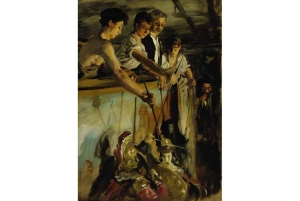
On May 22, 2013, Sotheby’s New York will offer a rare John Singer Sargent (1856-1925) painting as part of its annual spring auction of American Art. Marionettes (1903), which is expected to sell for between $5 million and $7 million, was part of Sargent’s personal collection for over 20 years and was passed down through the artist’s family to the present owner.
Best known for his portraits of members of high society, Marionettes is a departure from Sargent’s usual subjects. The painting depicts men from Philadelphia’s large Italian American community performing Sicilian puppet theater at the turn of the 20th century. When Sargent created the work, he was well established and considered to be the preeminent portrait painter of his time.
Eventually, Sargent grew tired of painting portraits and started traveling to seek out new inspirations. Sargent painted a number of marionette works during a four-month stint in Philadelphia. In 1909, Sargent ceased painting portraits of the elite altogether and decided to paint only what he wanted to.
Only six works by Sargent have ever appeared at auction and carried an estimate in excess of $5 million. Group with Parasols, which sold at Sotheby’s in 2004 for $23.5 million, set the record for the artist at auction.
Marionettes will go on view at Sotheby’s on May 18, 2013.
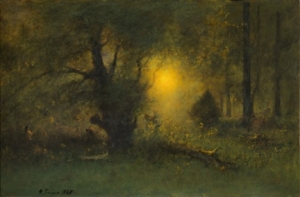
The Sterling and Francine Clark Institute in Williamstown, MA received its largest gift to date from New York-based collectors Frank Martucci, and his wife, Katherine. The Martuccis donated an impressive collection of works including eight landscapes by the 19th-century American painter George Inness (1825-1894).
The gift is extremely beneficial for the Clark, which focuses on collecting certain artists in depth; the museum currently boasts impressive collections of works by John Singer Sargent (1856-1925), Winslow Homer (1836-1910), and Pierre-Auguste Renoir (1841-1919). The Martuccis’ donation strengthens the Clark’s Inness holdings as they had only two paintings by the artist in their collection, which were acquired in 1955. The Martuccis also donated oil paintings by Eastman Johnson (1824-1906) and Gaston Latouche (1854-1913), an early watercolor landscape by Piet Mondrian (1872-1944), and five works by the Italian genre painter Mose Bianchi (1840-1904).
The new Inness landscapes will be featured in the exhibition George Inness: Gifts from Frank and Katherine Martucci from June 9 through September 8, 2013; the show will run concurrently with a major exhibition of paintings, watercolors, and prints by Winslow Homer.
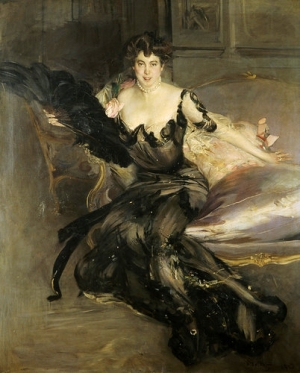
Edwardian Opulence: British Art at the Dawn of the Twentieth Century is now on view at the Yale Center for British Art in New Haven, CT and explores the art created in Britain during the reign of King Edward II. The period, which is known as the Edwardian era, lasted from 1901 to 1910.
Sandwiched between the rigid Victorian era and the devastation of World War I, the Edwardian era was a time of rapid technological growth, significant artistic development, shifting political and social structures, and increased consumption among the elite. Edwardian Opulence explores how all of these changes influenced the creation, consumption, and display of British art through a range of objects.
Highlights from the exhibition include portraits by John Singer Sargent (1856-1925) and Giovanni Boldini (1842-1931), diamond-studded tiaras, vivid Autochrome color photographs, bejeweled bell pushes by Carl Fabergé (1846-1920), and an extravagantly embellished gown that belonged to the American-born Vicereine of India.
The show is comprised of 170 works from public art museums and private collections. Lenders include Queen Elizabeth II, the British Museum, the Victoria and Albert Museum, Tate Britain, the Royal Academy of Arts, the Metropolitan Museum of Art, and the Musée d’Orsay. Edwardian Opulence will be on view through June 2, 2013.

New York’s Brooklyn Museum and Boston’s Museum of Fine Arts are joining forces to present a landmark exhibition of John Singer Sargent’s watercolors (1856-1925). The exhibition, aptly titled John Singer Sargent Watercolors, will bring together 93 works acquired by both museums during the early 20th century. The Brooklyn Museum’s 38 watercolors were largely purchased form Sargent’s 1909 debut exhibition in New York and The MFA’s works were acquired from a New York Gallery in 1912.
The institutions have been working together on a year-long study of Sargent’s watercolors, which he painted fervently. During his long career, Sargent created over 2,000 watercolors depicting everything from the English countryside to Venetian scenes as well as paintings of the Middle East, Montana, Maine, Florida, and the American west. Sargent painted a number of watercolor portraits of Bedouins and fishermen from the Middle East as well as the native people of the American west. A section of the exhibition will be devoted to the findings from the museums’ extensive study; the analysis revealed new insights into Sargent’s drawing techniques, paper preparation, and use of pigments.
John Singer Sargent Watercolors will go on view at the Brooklyn Museum on April 5, 2013 where it will remain until July 28, 2013. The exhibition will then travel to Boston’s Museum of Fine Arts where it will stay from October 13, 2013 until January 20, 2014. The show will make a final appearance at Houston’s Museum of Fine Arts in 2014.

Fine Lines: American Drawings from the Brooklyn Museum is now on view at the Brooklyn Museum in New York. The exhibition presents over 100 drawings and sketchbooks from the museum’s collection, many of which have rarely been seen.
Fine Lines features works created between 1768 and 1945 and includes drawings by more than 70 artists such as John Singleton Copley (1738-1815), Stuart Davis (1892-1964), Thomas Eakins (1844-1916), William Glackens (1870-1938), Marsden Hartley (1877-1943), Winslow Homer (1836-1910), Edward Hopper (1882-1967), Eastman Johnson (1824-1906), Georgia O’Keeffe (1887-1986), William Merritt Chase (1849-1916), and John Singer Sargent (1856-1925).
Fine Lines is organized into six categories and draws connections between artists from varying periods and artistic styles. Topics explored in the six sections are portraiture; the nude; the clothed figure; narrative subjects; natural landscapes; urban landscapes; and conservation techniques.
Fine Lines will be on view at the Brooklyn Museum through May 26, 2013.
Broadway’s “discovery” by William Morris (1834–1896), a principal figure in the English Arts and Crafts movement, spearheaded interest in the quiet village in the English Cotswolds (Fig. 1) and brought about its incarnation as an arts colony populated by a group of prominent painters, writers, musicians, and other creative souls who convened there in the mid-1880s, a tradition that continues today. The so-called “Broadway group” included a number of American expatriate painters, chief among them John Singer Sargent (1856–1925), hard at work on what would become his masterpiece, Carnation, Lily, Lily Rose (Fig. 2). Surrounding Sargent at this time was a congenial group of artist-friends whose relatives, spouses, and children posed, gardened, entertained, and established a sense of camaraderie in the sleepy village that bequeathed an enduring legacy as well as a remarkable group of artworks that capture the flavor of the colony.
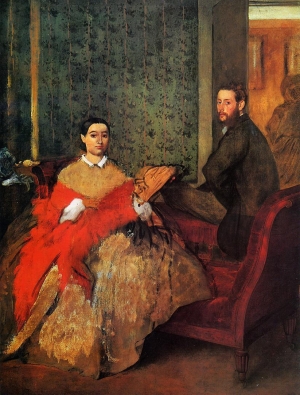
Patrons who are familiar with the permanent collection at Boston’s Museum of Fine Arts might become befuddled upon their next visit to the institution. Some of the museum’s finest works including Pierre-Auguste Renoir’s Dance at Bougival, the pivotal Claude Monet painting, La Japonaise: Camille Monet in a Japanese Costume, five works by Paul Cézanne, five more by Edouard Manet, and two of the masterpieces by Vincent Van Gogh are nowhere to be found.
While some of the works have been lent to museums in the United States, Japan, and Europe to enhance exhibitions, others have been rented to for-profit organizations. Loans between institutions are common practice, but compounded with the large number of works currently out on rent by the MFA, the museum’s own collection appears to be lacking. Currently, 26 of the MFA’s paintings are involved in exhibitions in Italy, which the institution received a hefty yet undisclosed fee for. Some of the works now on view in Italy are two paintings by John Singleton Copley and two Rembrandt portraits as well as single works by Eugène Delacroix, Paolo Veronese, Winslow Homer, John Singer Sargent, Paul Gauguin, Alberto Giacometti, and Pablo Picasso.
While the MFA is excited to be raising revenues, the act of charging fees for lending works has been a source of controversy. One of the main duties of public institutions, including art museums, is to share their collections with the public. Many objectors find the practice of lending works for profit to be in direct opposition to this goal.
Other major holdings that are not presently at the MFA are Diego Velázquez’s Luis de Gongora, two works by El Greco, two more by Gustave Courbet, the museum’s only painting by Edvard Munch, and arguably its greatest work by Edgar Degas, Edmondo and Therese Morbilli. While MFA officials argue that they are bolstering the museum’s international reputation, critics feel the institution is suffering for it.
|
|
|
|
|